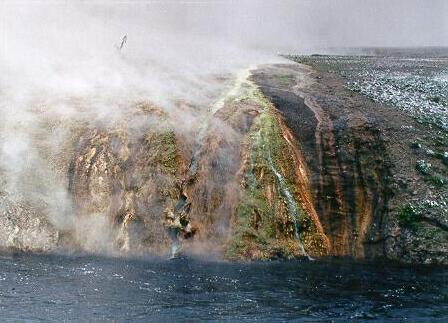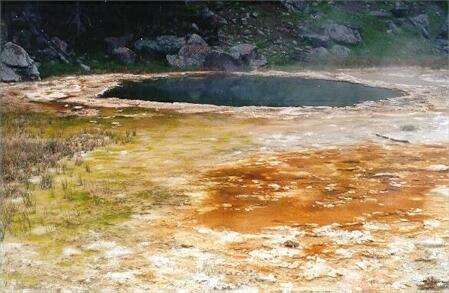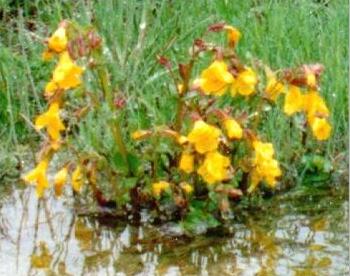| Thermophilic
microbes: Yellowstone National Park Yellowstone National Park (Wyoming,
USA) has one of the highest concentrations of thermal
features in the world. They include geysers, hot pools,
fumaroles (steam vents) and mudpots. The reason for this
large concentration of thermal features seems to be that
the earth's crust is much thinner here - estimated at
about 64 km (40 miles) compared to about 144 km (90
miles) over most other parts of the land surface. Hot
magma (molten rock) at depths of about 6-16 km heats the
overlying rock and the reservoirs of water lying 3-4 km
below the surface. This heated water is forced upwards
through fissures in the surface rocks, escaping as
boiling pools, gas vents or geysers. Thick deposits of
limestone are often seen around the thermal vents, where
calcium carbonate is precipitated from the underground
water.
Several heat-loving
(thermophilic) microorganisms grow within the heated
pools or in the channels of water that drain from them.
These bacteria and archaea are often brightly coloured by
photosynthetic pigments (chlorophylls or carotenoids) and
show distinct zonations according to their specific
temperature tolerances.

A large channel draining from a hot pool, containing
carotenoid-rich microorganisms. The temperature of this
channel in the foreground is about 60 oC.
Layers of white-coloured limestone (forming a rock
deposit known as travertine) can also be seen. Note the
footprints of buffalo in the foreground. These animals
often seek the warmth of thermal areas in the winter
months.
Left:
limestone terraces formed by precipitation from
calcium-rich water flowing from a raised hot pool. Pink,
green and brown-coloured microorganisms occupy the
thermal gradients in the flowing water (60-100oC).
Right: a pool of water that has condensed from a a
fumarole (steam/gas vent at top right of the image), with
abundant growth of a green photosynthetic microorganism.

Zones of microbial growth in water draining into the
Yellowstone River from a raised thermal vent.

Zonation of microorganisms in the seep from a hot pool.
The temperature gradient decreases from right to left of
the image, where the temperature is low enough to enable
plants to grow.

Part of a water seepage from a hot spring, showing
carpets of cyanobacteria and other microbial species. The
upper temperature limit for growth of cyanobacteria is
70-74oC.
The rim of this pool is colonised by grasses/sedges and
by monkey flower (Mimulus guttatus) - a species
also found in Britain (see below).

Monkey flower at the edge of a heated pool.
Go back to Thermophilic
microorganisms?
GO TO FULL LIST OF PROFILES?
|